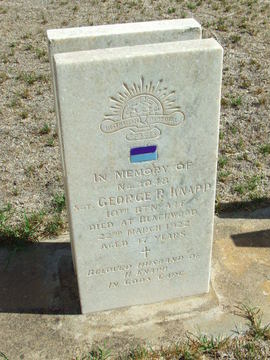KNAPP, George Russell
| Service Numbers: | 3284 , 3284 |
|---|---|
| Enlisted: | 23 April 1915 |
| Last Rank: | Private |
| Last Unit: | 10th Infantry Battalion |
| Born: | Parish of Limehouse, London, England , date not yet discovered |
| Home Town: | Not yet discovered |
| Schooling: | Not yet discovered |
| Occupation: | Clerk |
| Died: | SweetHome Blackwood Adelaide South Australia, 22 March 1922, cause of death not yet discovered, age not yet discovered |
| Cemetery: |
West Terrace Cemetery (AIF Section) Section: LO, Road: 4N, Site No: 8 |
| Memorials: |
World War 1 Service
| 23 Apr 1915: | Enlisted AIF WW1, Private, 3284 , 10th Infantry Battalion | |
|---|---|---|
| 27 Oct 1915: | Involvement Private, 3284, 10th Infantry Battalion, --- :embarkation_roll: roll_number: '10' embarkation_place: Adelaide embarkation_ship: HMAT Benalla embarkation_ship_number: A24 public_note: '' | |
| 27 Oct 1915: | Embarked Private, 3284, 10th Infantry Battalion, HMAT Benalla, Adelaide | |
| 4 Jan 1918: | Discharged AIF WW1, 3284 |
Help us honour George Russell Knapp's service by contributing information, stories, and images so that they can be preserved for future generations.
Add my storyBiography contributed by St Ignatius' College
George Russell Knapp was born in 1877 and was the only son of the late G. L. and J. Knapp and brother of Rosie Bahelor. He was born in the Parish of Limehouse in London, England. He later moved to Adelaide, Australia, where he lived with Harriett Knapp at Lower House, Palmerston Road, North Unley. Before enlisting in the war, he was a clerk by occupation. He also had previously served in the N J Wales Army Service Corps and left voluntarily.
He joined the Australian Imperial Force on the 23rd of April 1915, at the age of 38 years and 9 months. He embarked for service abroad on the 27th of October 1915 on the ex-passenger liner, HMAT Ascanius as part of the 10th Infantry Battalion. They were the first South Australian Infantry unit to be deployed overseas during the war.
George Russell Knapp was first appointed to the D Company Base Infantry of the 10th Infantry Battalion on 23.4.1915. He subsequently joined the 8th re-inforcement on 12.5.1915 and then the 12th re-inforcement from 16.10.1915 to 1.4.1916.
The 10th Battalion was formed on 17.8.1914 at the Morphettville Racecourse in Adelaide under Lieutenant Colonel Stanley Price Weir. It was attached to the 3rd Infantry Brigade along with the 9th, 11th, and 12th Battalions. In January and February 1915, the 10th Battalion was organised into a 4-company structure designated A to D. George Russell Knapp joined the D Company on 23.4. 1915. Each company consisted of 228 men across 4 platoons.
The 10th Battalion had a distinctive blue and purple unit colour patch issued to it on the 15th of April 1915.
On the 24th of April 1915, the 10th Battalion embarked for Gallipolli. Two companies and the Battalion Headquarters were allocated to the battleship HMS Prince of Wales, while the other two companies went on board 2 destroyers – “Scourge” and “Foxhound”. The 10th Battalion was one of the first units to come ashore at Anzac cove as part of the covering force for the main Anzac landing during the early hours of 25th April 1915. The 10th Battalion penetrated the furthest inland than any other Australian unit amid fierce opposition. The 10th Battalion remained in Gallipolli until it was evacuated in December 1915. They defended the beachhead.
After withdrawing from the peninsula, the 10th Battalion set sail for Egypt reaching Alexandria on the 29th of December 1915 and remained there till 1916 where the Australian Imperial Force was expanded and re-organised in preparation for deployment to the European battlefield. As part of this process, the 10th Battalion provided a cadre of experienced personnel to the 50th Battalion. George Russell Knapp was one of them. Knapp joined the 50th Battalion on the 2nd of April 1916.
In April 1916 Knapp, however, developed dysentery after which he fell ill very often leading to multiple hospital admissions. He was admitted to a hospital in Cairo, Egypt on the 25th of April 1916 with general debility. He was noted to be anaemic, malnourished and had abdominal pain after meals with eructation. He was diagnosed with chronic gastritis. After his discharge from the hospital in Cairo, he returned to duty but had recurrent hospital admissions later in France and many hospitals in England with the same symptoms. Though he was deemed medically fit at the time of joining the AIF, he became unwell after the diarrhoeal episode. His chronic ill health precluded him from continuing in army service. He was determined to be medically unfit for service permanently on 24th August 1917 and was sent back to Australia in September 1917 reaching on the 21st of November 1917. He was discharged from military service on the 4th of January 1918 after a total duration of service of 2 years and 257 days.
After serving in the war Knapp moved residence from Unley to Blackwood SA. He lived in a house called Sweet Home with his wife Hettie. He passed away on the 22nd of March 1922 at the age of 47. He was then buried at the AIF cemetery in West Terrace – South Ward Adelaide. His wife Harriet Knapp was the recipient of his army pension.









